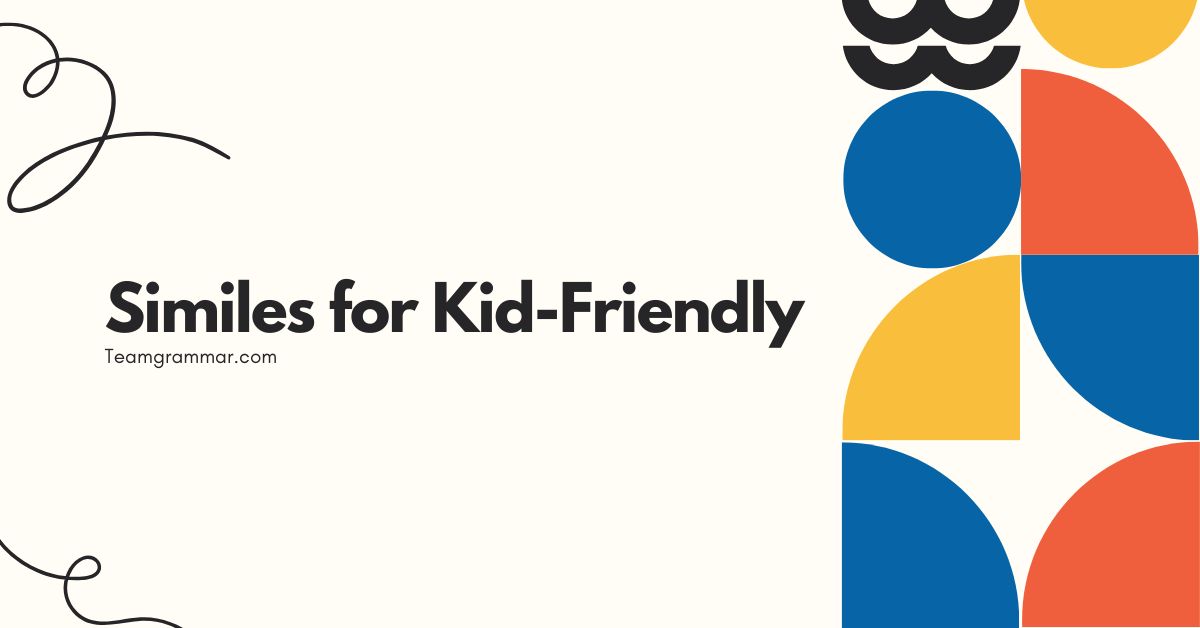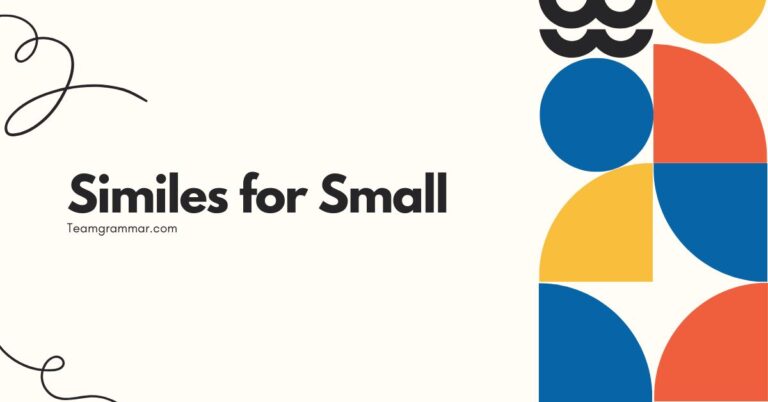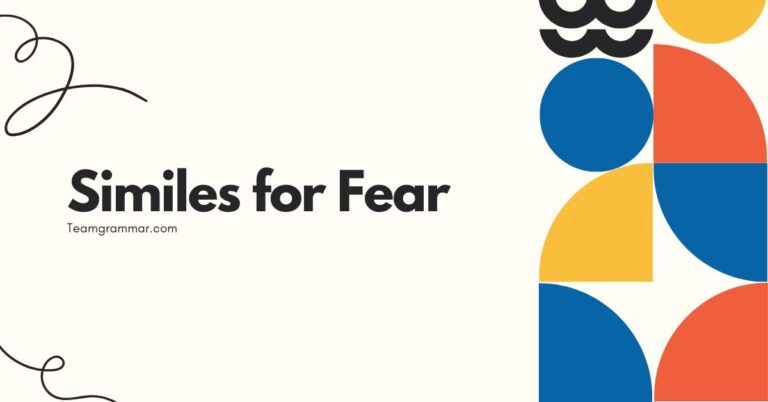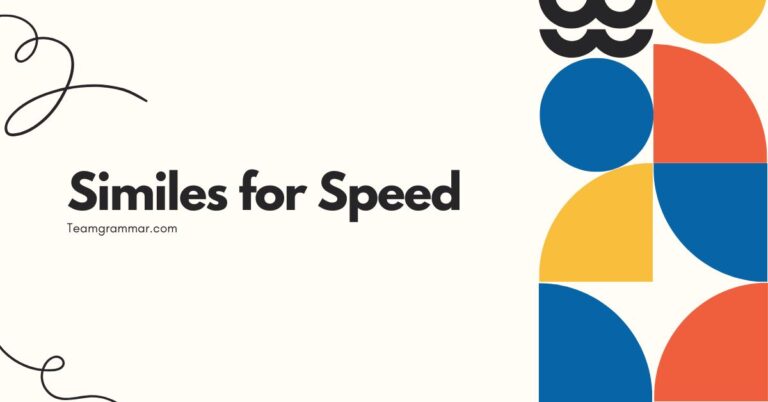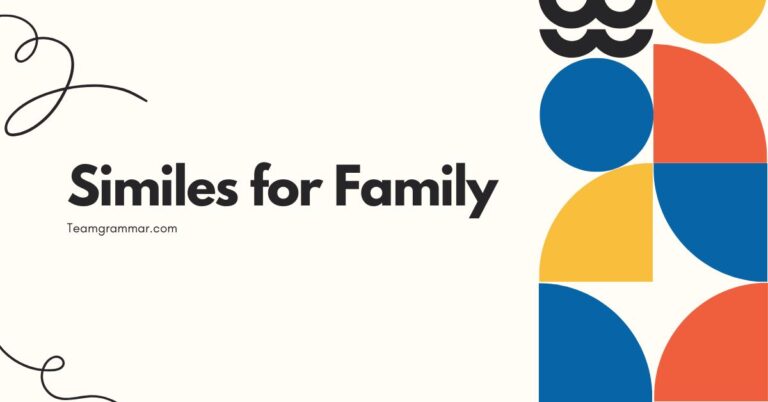33 Kid-Friendly Similes: Making Comparisons Fun and Easy
Similes are a fantastic way to make writing more vivid and engaging, especially for young learners. They allow us to compare two different things, highlighting their similarities in a creative and imaginative way.
Understanding and using similes not only enhances a child’s vocabulary and writing skills but also encourages them to think critically and make connections between seemingly unrelated concepts. This article will guide you through the world of kid-friendly similes, providing clear explanations, fun examples, and helpful exercises to master this important literary device.
Whether you’re a teacher, parent, or student, this resource will help you unlock the power of similes and make learning grammar an enjoyable adventure.
Table of Contents
- Introduction
- What is a Simile?
- Classification of Similes
- Function of Similes
- Context of Similes
- Structural Breakdown of a Simile
- Types of Similes
- Positive Similes
- Negative Similes
- Humorous Similes
- Examples of Kid-Friendly Similes
- Similes Describing Appearance
- Similes Describing Behavior
- Similes Describing Feelings
- Similes Describing Sounds
- Similes Describing Taste
- Usage Rules for Similes
- Using ‘Like’ and ‘As’ Correctly
- Ensuring Clarity in Similes
- Avoiding Clichés in Similes
- Common Mistakes with Similes
- Practice Exercises
- Exercise 1: Identifying Similes
- Exercise 2: Completing Similes
- Exercise 3: Creating Similes
- Advanced Topics: Similes and Metaphors
- Frequently Asked Questions (FAQs)
- Conclusion
What is a Simile?
Asimileis a figure of speech that compares two unlike things using the words “like” or “as.” Similes are used to make descriptions more vivid and interesting by drawing a connection between something familiar and something new or unfamiliar. They help create a clearer image in the reader’s mind and make writing more engaging.
For example, instead of saying “The sun is bright,” you could use a simile and say, “The sun is as bright as a lightbulb.” This comparison helps the reader understand just how bright the sun is by relating it to something they already know.
Classification of Similes
Similes can be classified based on the type of comparison they make. They can describe physical attributes, emotions, behaviors, or even abstract concepts.
The key is that they always involve a comparison using “like” or “as.” Understanding these classifications can help in crafting more effective and descriptive similes.
Function of Similes
The primary function of a simile is to enhance descriptions and make them more relatable. By comparing something unfamiliar to something familiar, similes help readers understand and visualize the subject more easily.
They also add depth and richness to writing, making it more engaging and memorable. Similes can also evoke emotions or create a specific mood, depending on the comparison being made.
Context of Similes
The context in which a simile is used is crucial to its effectiveness. A simile that works well in one situation might not be appropriate in another.
It’s important to consider the audience and the overall tone of the writing when choosing a simile. For example, a humorous simile might be suitable for a lighthearted story, but not for a serious essay.
The goal is to choose a simile that enhances the writing and resonates with the reader.
Structural Breakdown of a Simile
A simile typically consists of three main components: thesubject(the thing being described), thelinking word(“like” or “as”), and thereference(the thing being compared to). The subject and reference are usually different things, but they share a common characteristic that the simile highlights.
For instance, in the simile “She is as brave as a lion,” “she” is the subject, “as” is the linking word, and “a lion” is the reference. The simile emphasizes the shared characteristic of bravery between the subject and the reference.
The basic structure is:Subject + Linking Word (“like” or “as”) + Reference. Recognizing this structure makes it easier to identify and create similes.
The subject is what you are describing, and the reference is what you are comparing it to. The linking word bridges the two, making the comparison explicit.
Types of Similes
While all similes use “like” or “as” to make comparisons, they can be categorized based on the nature of the comparison they make and the effect they create. Here are a few common types:
Positive Similes
Positive similes are used to describe something in a favorable or complimentary way. They highlight the positive qualities of the subject by comparing it to something that is generally considered to be good or desirable.
These similes often evoke feelings of admiration or appreciation.
Negative Similes
Negative similes, on the other hand, are used to describe something in an unfavorable or critical way. They highlight the negative qualities of the subject by comparing it to something that is generally considered to be bad or undesirable.
These similes can evoke feelings of dislike or disapproval.
Humorous Similes
Humorous similes are used to create a funny or amusing effect. They often involve comparisons that are unexpected or absurd.
These similes can be a great way to add levity to writing and make it more entertaining.
Examples of Kid-Friendly Similes
Let’s explore some examples of similes that are easy for kids to understand and relate to. These examples are categorized to help you see how similes can be used to describe different aspects of a subject.
Similes Describing Appearance
These similes focus on physical attributes and how things look. They can describe color, shape, size, or any other visual quality.
The following table provides several examples of similes focused on describing appearance, which can help children understand and appreciate how similes can be used to paint vivid pictures with words.
| Simile | Explanation |
|---|---|
| Her eyes were as blue as the ocean. | Comparing the color of her eyes to the deep blue of the ocean. |
| The snow was like a white blanket on the ground. | Comparing the covering of snow to a soft, white blanket. |
| The flower was as red as a fire truck. | Comparing the flower’s bright red color to a fire truck. |
| His hair was like a bird’s nest. | Comparing his messy hair to the tangled structure of a bird’s nest. |
| The moon was as round as a pizza. | Comparing the moon’s shape to the circular shape of a pizza. |
| The tall building was like a giant reaching for the sky. | Comparing the building’s height to a giant trying to touch the sky. |
| The clouds were like fluffy cotton candy. | Comparing the clouds’ appearance to the light and airy texture of cotton candy. |
| Her skin was as soft as a baby’s. | Comparing the softness of her skin to that of a baby’s. |
| The diamond sparkled like a star. | Comparing the diamond’s shine to the twinkling light of a star. |
| The old book was as yellow as aged parchment. | Comparing the color of the old book to the yellowed color of old parchment. |
| The river was like a silver ribbon winding through the valley. | Comparing the river’s appearance to a shiny, silver ribbon. |
| The leaves were as green as emeralds. | Comparing the leaves’ color to the vibrant green of emeralds. |
| The kitten’s fur was like velvet. | Comparing the softness of the kitten’s fur to the smooth texture of velvet. |
| The grapes were as purple as royalty. | Comparing the color of the grapes to the deep purple associated with royalty. |
| The mountain was like a sleeping giant. | Comparing the mountain’s size and shape to a giant lying down. |
| The little house looked as cozy as a gingerbread house. | Comparing the house’s inviting appearance to that of a gingerbread house. |
| The sunset was like a painting in the sky. | Comparing the vibrant colors of the sunset to the artistry of a painting. |
| The snowman was as white as snow. | Comparing the snowman’s color to the pure white of fresh snow. |
| The spiderweb was like a delicate lace. | Comparing the intricate pattern of the spiderweb to the fine detail of lace. |
| The old car was as rusty as an anchor left at sea. | Comparing the car’s rustiness to that of an anchor exposed to seawater. |
| The puppy’s eyes were as big as saucers. | Comparing the size of the puppy’s eyes to the round shape of saucers. |
| The knight’s armor was like a shiny mirror. | Comparing the armor’s reflective surface to a mirror. |
Similes Describing Behavior
These similes focus on how people or animals act. They can describe mannerisms, habits, or reactions.
The following table presents a variety of similes that describe behavior, providing examples of how to use vivid comparisons to illustrate actions and mannerisms in a kid-friendly manner.
| Simile | Explanation |
|---|---|
| He eats like a pig. | Comparing his messy eating habits to a pig’s. |
| She sings like an angel. | Comparing her beautiful singing voice to that of an angel. |
| They fought like cats and dogs. | Comparing their constant arguing to the stereotypical fighting of cats and dogs. |
| He runs as fast as a cheetah. | Comparing his speed to the fast running of a cheetah. |
| She sleeps like a log. | Comparing her deep sleep to the stillness of a log. |
| The children played like wild monkeys. | Comparing their energetic and unrestrained play to the behavior of wild monkeys. |
| He works like a busy bee. | Comparing his diligent work ethic to the industriousness of a bee. |
| She swims like a fish. | Comparing her natural swimming ability to that of a fish. |
| He jumps like a kangaroo. | Comparing his jumping ability to the powerful jumps of a kangaroo. |
| The baby crawls as slow as a snail. | Comparing the baby’s slow crawling speed to that of a snail. |
| She dances like a butterfly. | Comparing her graceful movements to the fluttering flight of a butterfly. |
| He reads as much as a bookworm. | Comparing his reading habits to the voracious reading of a bookworm. |
| She giggles like a little bird. | Comparing her cheerful giggle to the chirping of a small bird. |
| He roars like a lion when he’s angry. | Comparing his loud angry outburst to the roar of a lion. |
| She sneaks around like a cat. | Comparing her stealthy movements to the quiet movements of a cat. |
| He chatters like a monkey. | Comparing his constant talking to the chattering of a monkey. |
| She follows like a lost puppy. | Comparing her devoted following to the way a lost puppy follows. |
| He struts like a peacock. | Comparing his proud and showy behavior to the strutting of a peacock. |
| She pounces like a tiger. | Comparing her sudden and forceful actions to the pouncing of a tiger. |
| He watches like a hawk. | Comparing his attentive observation to the keen watchfulness of a hawk. |
Similes Describing Feelings
These similes focus on emotions and how people feel. They can describe happiness, sadness, anger, or any other emotion.
This section provides examples of similes used to describe various feelings, which helps children understand how to express emotions through creative comparisons.
| Simile | Explanation |
|---|---|
| He was as happy as a clam. | Comparing his happiness to the contentment of a clam. |
| She was as sad as a rainy day. | Comparing her sadness to the gloomy atmosphere of a rainy day. |
| He was as angry as a bull. | Comparing his anger to the rage of a bull. |
| She felt like a fish out of water. | Comparing her feeling of being out of place to a fish struggling on land. |
| He was as nervous as a cat in a room full of rocking chairs. | Comparing his nervousness to the unease of a cat in a precarious situation. |
| She felt as light as a feather. | Comparing her feeling of ease to the weightlessness of a feather. |
| He was as excited as a kid in a candy store. | Comparing his excitement to the joy of a child surrounded by candy. |
| She was as brave as a lion when she stood up to the bully. | Comparing her courage to the bravery of a lion. |
| He felt as lonely as a single star in the night sky. | Comparing his feeling of isolation to the solitude of a single star. |
| She was as content as a cat napping in the sun. | Comparing her contentment to the peacefulness of a cat resting in the sun. |
| He felt as lost as a sheep without a shepherd. | Comparing his feeling of being lost to the vulnerability of a sheep without guidance. |
| She was as free as a bird soaring through the sky. | Comparing her sense of freedom to the unrestricted flight of a bird. |
| He felt as heavy as lead when he heard the bad news. | Comparing his feeling of burden to the heaviness of lead. |
| She was as calm as a still lake. | Comparing her calmness to the undisturbed surface of a lake. |
| He felt as small as an ant under a magnifying glass. | Comparing his feeling of insignificance to the magnified view of an ant. |
| She was as hopeful as a flower reaching for the sun. | Comparing her optimism to the flower’s natural inclination to seek sunlight. |
| He felt as empty as a classroom during summer vacation. | Comparing his sense of emptiness to the deserted atmosphere of a school during the break. |
| She was as joyful as a child on Christmas morning. | Comparing her happiness to the excitement of a child on Christmas. |
| He felt as trapped as a fly in a spiderweb. | Comparing his feeling of being trapped to the fly’s predicament. |
| She was as peaceful as a sleeping baby. | Comparing her peaceful state to the tranquility of a sleeping baby. |
Similes Describing Sounds
These similes focus on auditory experiences and how things sound. They can describe loudness, pitch, or any other quality of sound.
This section provides examples of similes used to describe various sounds, which helps children understand how to express sounds through creative comparisons.
| Simile | Explanation |
|---|---|
| The thunder was like a roaring lion. | Comparing the loud sound of thunder to the roar of a lion. |
| Her laughter was like tinkling bells. | Comparing the sound of her laughter to the light sound of bells. |
| The music was as soft as a whisper. | Comparing the quietness of the music to a gentle whisper. |
| The squeaky door sounded like a crying baby. | Comparing the unpleasant sound of the door to the sound of a crying baby. |
| The leaves rustled like whispers in the wind. | Comparing the gentle sound of rustling leaves to hushed whispers. |
| The rain sounded like drumming fingers on the roof. | Comparing the rhythmic sound of rain to the sound of fingers drumming. |
| The car’s engine was as loud as a jet taking off. | Comparing the loudness of the engine to the powerful sound of a jet. |
| The waves crashed like thunder on the shore. | Comparing the loud crash of waves to the sound of thunder. |
| His voice was as smooth as honey. | Comparing the pleasant sound of his voice to the smoothness of honey. |
| The alarm clock was as shrill as a bird’s cry. | Comparing the sharp sound of the alarm to a bird’s piercing cry. |
| The wind howled like a wolf. | Comparing the sound of the wind to the howl of a wolf. |
| The clock ticked as loud as a heartbeat in the quiet room. | Comparing the noticeable ticking of the clock to a heartbeat. |
| The baby cooed as sweet as a songbird. | Comparing the baby’s cooing to the sweet sound of a songbird. |
| The fire crackled like popcorn in a pot. | Comparing the crackling sound of the fire to popcorn. |
| The siren wailed as loud as a banshee. | Comparing the siren’s wail to the mythical banshee’s cry. |
| The floorboards creaked like an old man’s knees. | Comparing the creaking sound to the sound of old knees. |
| The crickets chirped like a chorus of tiny singers. | Comparing the chirping of crickets to a chorus of singers. |
| The waterfall roared like a thousand voices. | Comparing the sound of the waterfall to many voices. |
| The balloon popped as loud as a firecracker. | Comparing the popping noise to a firecracker. |
| The dog barked as deep as a foghorn. | Comparing the dog’s bark to the sound of a foghorn. |
Similes Describing Taste
These similes focus on gustatory experiences and how things taste. They can describe sweetness, sourness, bitterness, or any other quality of taste.
This section provides examples of similes used to describe various tastes, which helps children understand how to express tastes through creative comparisons.
| Simile | Explanation |
|---|---|
| The candy was as sweet as honey. | Comparing the candy’s sweetness to the sweetness of honey. |
| The lemon was as sour as vinegar. | Comparing the lemon’s sourness to the acidity of vinegar. |
| The medicine tasted like old socks. | Comparing the medicine’s unpleasant taste to the smell of old socks. |
| The soup was as bland as plain water. | Comparing the soup’s lack of flavor to the tastelessness of water. |
| The spices made the dish as hot as fire. | Comparing the dish’s spiciness to the heat of fire. |
| The chocolate was as rich as a king’s treasure. | Comparing the chocolate’s richness to the value of a treasure. |
| The coffee was as bitter as medicine. | Comparing the coffee’s bitterness to the taste of medicine. |
| The fruit was as juicy as a water balloon. | Comparing the fruit’s juiciness to a water balloon. |
| The salt was as sharp as tiny needles on my tongue. | Comparing the salt’s taste to the prickling sensation of needles. |
| The pie was as comforting as a warm hug. | Comparing the pie’s taste to the feeling of a warm hug. |
| The ice cream was as cool as a winter breeze. | Comparing the ice cream’s coldness to a winter breeze. |
| The sauce was as smooth as silk. | Comparing the texture of the sauce to the smoothness of silk. |
| The cake was as light as air. | Comparing the light texture of the cake to air. |
| The toast was as crunchy as autumn leaves. | Comparing the crunchiness of the toast to leaves. |
| The tea was as soothing as a lullaby. | Comparing the tea’s soothing effect to a lullaby. |
| The lemonade was as refreshing as a dip in the pool. | Comparing the lemonade’s refreshing quality to a swim. |
| The bread was as soft as a cloud. | Comparing the bread’s softness to a cloud. |
| The pepper was as spicy as a dragon’s breath. | Comparing the pepper’s spiciness to a dragon’s breath. |
| The grapes were as plump as little balloons. | Comparing the grapes’ plumpness to balloons. |
| The soup was as warm as sunshine. | Comparing the soup’s warmth to sunshine. |
Usage Rules for Similes
Using similes effectively involves following a few key rules to ensure clarity and impact.
Using ‘Like’ and ‘As’ Correctly
The words “like” and “as” are the foundation of similes. “Like” is used to compare nouns or pronouns, while “as” is used to compare clauses or phrases.
For example: “He runs like the wind” (comparing nouns) vs. “He runs as fast as the wind blows” (comparing clauses).
Ensuring Clarity in Similes
A good simile should be easy to understand. The comparison should be clear and logical.
Avoid comparing things that have no obvious connection. For example, “The car was as fast as a snail” doesn’t make sense because snails are known for being slow.
Avoiding Clichés in Similes
A cliché is an overused phrase that has lost its impact. Avoid using common similes like “as busy as a bee” or “as strong as an ox.” Try to come up with original and creative comparisons that will surprise and delight your readers.
Common Mistakes with Similes
One common mistake is confusing similes with metaphors. While both are figures of speech that make comparisons, similes use “like” or “as,” whereas metaphors state that something *is* something else.
For example, “He is like a lion” (simile) vs. “He is a lion” (metaphor).
Another mistake is creating illogical or unclear comparisons. Ensure that the things you are comparing have a clear connection.
For example:
- Incorrect: The book was as loud as a tree.
- Correct: The book was as heavy as a brick.
Using clichés is also a common pitfall. Strive for originality to make your writing more engaging.
Practice Exercises
Test your understanding of similes with these exercises.
Exercise 1: Identifying Similes
Identify the similes in the following sentences and explain what is being compared.
| Question | Answer |
|---|---|
| 1. The dog’s fur was as white as snow. | Simile: “as white as snow.” Comparison: The dog’s fur is being compared to the color of snow. |
| 2. He roared with laughter. | Not a simile. This is an example of personification. |
| 3. The baby slept like a log. | Simile: “like a log.” Comparison: The baby’s deep sleep is being compared to the stillness of a log. |
| 4. She is a shining star. | Not a simile. This is a metaphor. |
| 5. The car moved as fast as a rocket. | Simile: “as fast as a rocket.” Comparison: The car’s speed is being compared to the speed of a rocket. |
| 6. The sun was hot. | Not a simile. This is a statement of fact. |
| 7. The girl was as gentle as a lamb. | Simile: “as gentle as a lamb.” Comparison: The girl’s gentleness is being compared to the gentleness of a lamb. |
| 8. The music sounded like a dream. | Simile: “like a dream.” Comparison: The sound of the music is being compared to a dream. |
| 9. Time is money. | Not a simile. This is a metaphor. |
| 10. The old house stood as silent as a ghost. | Simile: “as silent as a ghost.” Comparison: The silence of the old house is being compared to the silence of a ghost. |
Exercise 2: Completing Similes
Complete the following similes with appropriate endings.
| Question | Answer |
|---|---|
| 1. The ice was as cold as _____. | The ice was as cold as winter. |
| 2. He was as brave as _____. | He was as brave as a lion. |
| 3. She sings like _____. | She sings like an angel. |
| 4. The car was as fast as _____. | The car was as fast as lightning. |
| 5. The night was as dark as _____. | The night was as dark as ink. |
| 6. The water was as clear as _____. | The water was as clear as glass. |
| 7. They fought like _____. | They fought like cats and dogs. |
| 8. The mountain was as tall as _____. | The mountain was as tall as the sky. |
| 9. He eats like _____. | He eats like a horse. |
| 10. She is as happy as _____. | She is as happy as a lark. |
Exercise 3: Creating Similes
Create similes to describe the following subjects.
| Question | Answer |
|---|---|
| 1. A sunny day | A sunny day is like a warm hug. |
| 2. A loud noise | A loud noise is like a thunderclap. |
| 3. A soft pillow | A soft pillow is like a cloud. |
| 4. A fast runner | A fast runner is like a cheetah. |
| 5. A sad feeling | A sad feeling is like a rainy day. |
| 6. A sweet candy | A sweet candy is like pure sugar. |
| 7. A strong wind | A strong wind is like a roaring beast. |
| 8. A bright star | A bright star is like a diamond in the sky. |
| 9. A quiet room | A quiet room is like a peaceful forest. |
| 10. A rough surface | A rough surface is like sandpaper. |
Advanced Topics: Similes and Metaphors
While similes and metaphors both make comparisons, they do so in different ways. Asimileuses “like” or “as” to make an explicit comparison, while ametaphorimplies a comparison by stating that something *is* something else.
Understanding the nuances between these two figures of speech can elevate your writing to a more sophisticated level.
For example:
- Simile: The athlete was as strong as an ox.
- Metaphor: The athlete was an ox.
The metaphor carries a stronger, more direct comparison, suggesting a complete identification between the athlete and the ox. Choosing between a simile and a metaphor depends on the desired effect and the level of emphasis you want to convey.
Frequently Asked Questions (FAQs)
- What is the difference between a simile and a metaphor?
A simile compares two things using “like” or “as,” while a metaphor directly states that one thing *is* another. Similes are generally considered less direct and more descriptive, whereas metaphors are more forceful and suggestive.
- Why are similes important in writing?
Similes enhance descriptions, make writing more vivid, and help readers understand unfamiliar concepts by relating them to familiar ones. They also add creativity and interest to writing, making it more engaging and memorable.
- How can I avoid using clichés in my similes?
To avoid clichés, think outside the box and try to come up with original comparisons. Consider the specific qualities you want to emphasize and brainstorm unique connections between the subject and reference. Ask yourself if you’ve heard the phrase many times before; if so, it’s likely a cliché.
- Can a simile be too complex for kids to understand?
Yes, it’s important to use similes that are age-appropriate and relatable to children’s experiences. Avoid using obscure references or abstract concepts that might be difficult for them to grasp. Keep the comparisons simple and straightforward.
- Is it okay to
use similes in formal writing?
Yes, similes can be used in formal writing, but they should be used judiciously and with purpose. Ensure that the similes enhance the clarity and impact of your writing, rather than distracting from it. Avoid using overly casual or informal comparisons in formal contexts.
Conclusion
Similes are a powerful tool for enhancing writing and making it more engaging for readers of all ages. By understanding what similes are, how they work, and how to use them effectively, children can develop their vocabulary, improve their writing skills, and express themselves more creatively.
Keep practicing with the examples and exercises provided, and soon you’ll be crafting your own amazing similes!

